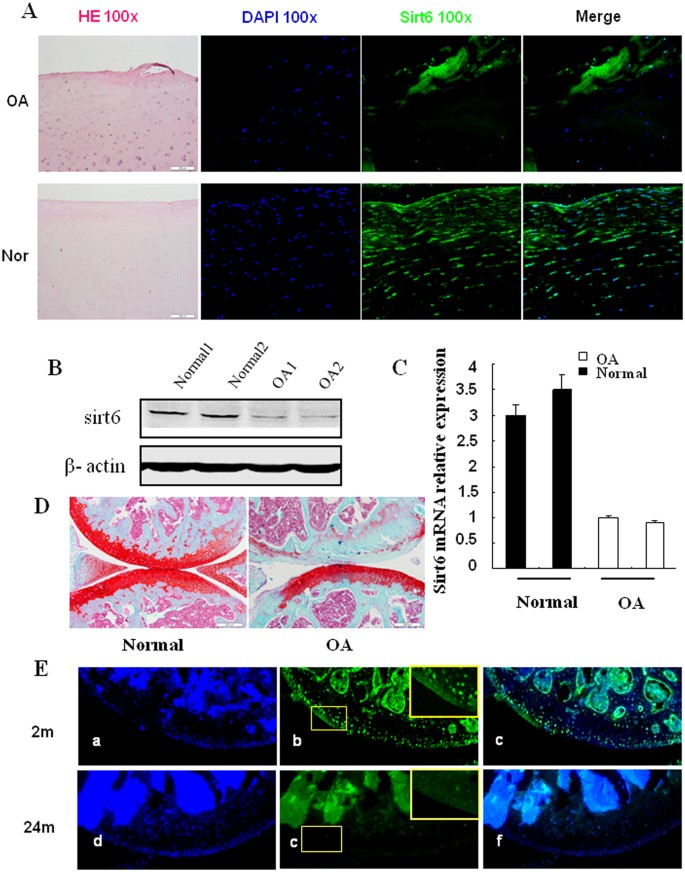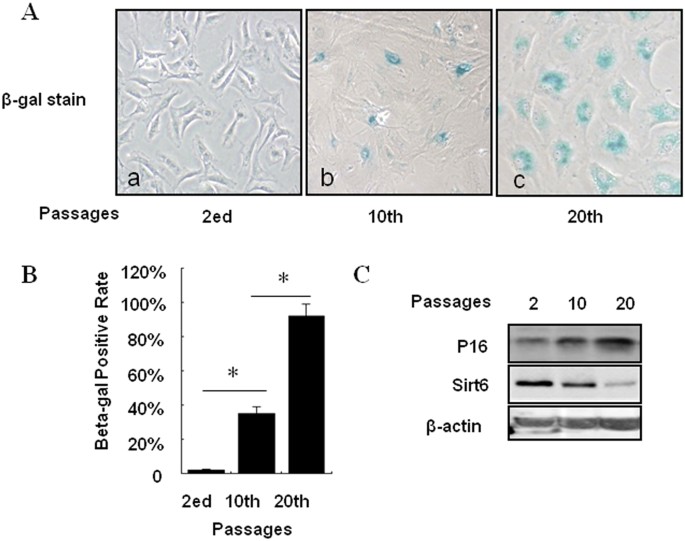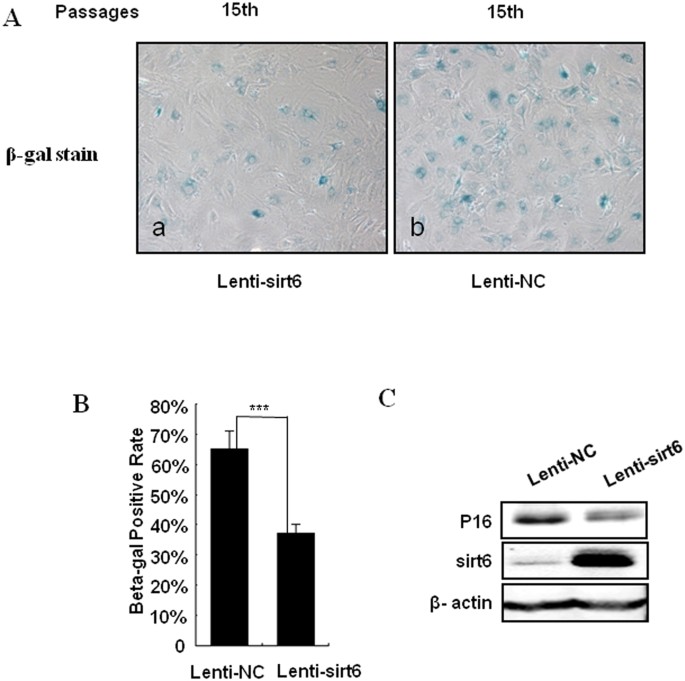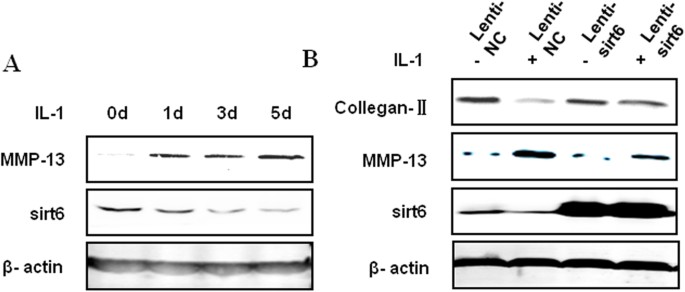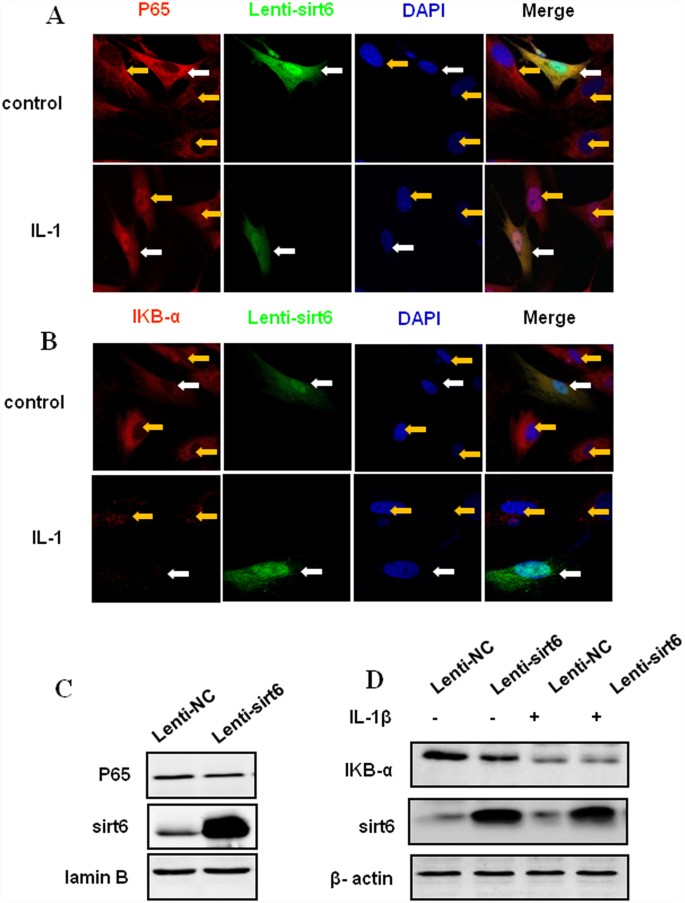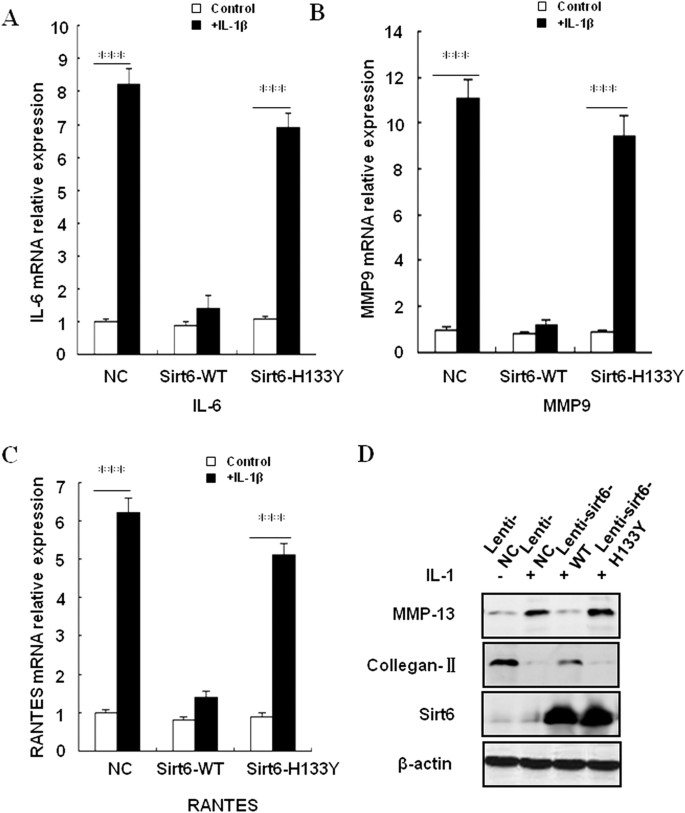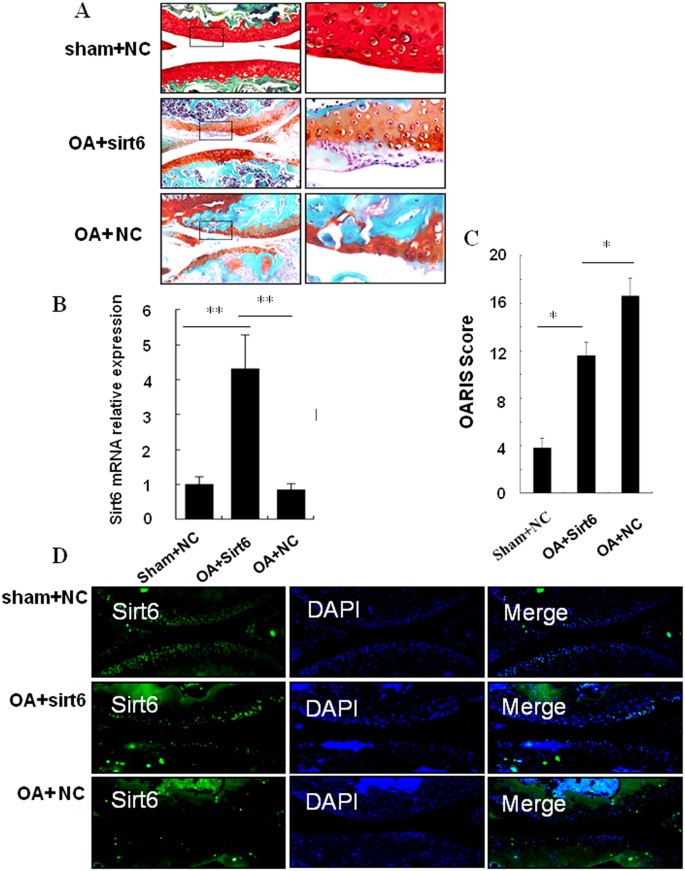Overexpression of Sirtuin 6 suppresses cellular senescence and NF-κB mediated inflammatory responses in osteoarthritis development (original) (raw)
Introduction
Osteoarthritis (OA) is an age-related degenerative disease of the joint which is mainly characterized by the progressive degradation of cartilage with tissular inflammatory phase, along with joint pain and stiffness1,2,3. It affects millions of individuals across the world resulting in impaired quality of life and increased health costs. The roles of inflammation and aging in the pathophysiology of OA have been well established4,5,6. However, the underlying molecular mechanisms are not completely clarified yet. Therefore, studies on the mechanisms of aging and inflammation may also shed some light on understanding the pathogenesis or getting new therapeutic target of OA.
Sirt6 is a member of the sirtuins family (Sirt1-7) of histone deacetylases which has been implicated in aging, inflammatory and metabolic pathways7,8,9. The Sirt6 –/– mice exhibit postnatal growth retardation and have a greatly shortened lifespan and show degenerative and metabolic defects reminiscent of premature aging syndromes. Piao et al. identified that Sirt6 could regulate postnatal growth plate differentiation and proliferation10. Sirt6 deficiency inhibited chondrogenesis. Lee et al. revealed overexpression of Sirt6 could suppress inflammatory responses of synoviocytes induced by TNF-α11. Moreover, they demonstrated that Sirt6 inhibited bone destruction in collagen-induced arthritic mice by suppressing osteoclast differentiation11. However, to our knowledge, there is still no study identifying the roles of Sirt6 in cartilage or/and osteoarthritis.
In the present study, we hypothesize that Sirt6 has a significant relationship with OA development. Overexpression or activation of Sirt6 can prevent the progression of osteoarthritis. To test this hypothesis, we characterized the protective effects of Sirt6 in IL-1β-treated chondrocytes. The mechanistic pathway of Sirt6 involvement in chondrocytes denegeration was also investigated in vitro. The role of Sirt6 in OA development in vivo was studied in the model of mice OA knee joints.
Material and Methods
Reagents and antibodies
Dulbecco’s Modified Eagle Medium: Nutrient Mixture F-12 (DMEM/F-12) Media is obtained from Hyclone (Utah, USA). Penicillin, streptomycin and fetal bovine serum (FBS) were obtained from Gibco BRL (Grand Island, NY, USA). Recombinant human and mouse IL-1β were obtained from R&D Systems (Minneapolis, MN). The antibodies used in this study are as follow: anti-sirt6 from Abcam (Cambridge, MA); anti-NF-κB p65 and anti-IKb-α from Cell Signaling Technology (Danvers, MA); anti-actin from Sigma; anti-collogan II from Chemicon (Temecula, CA); anti-MMP-13 from Santa Cruz Biotechnology (Santa Cruz, CA); Alexa-Fluor-488- and Alexa-Fluor-545-tagged second antibodies were from Molecular Probes (Eugene, OR); secondary antibodies goat anti-rabbit IRDye 800CW and goat anti-mouse IRDye 680 were from LI-COR Biosciences (Lincoln, NE).
Mice, human articular cartilage, chondrocyte culture
The C57 mice (Animal Center of Zhejiang University) were used in this study. Three-month and Twenty four-month old mice were used for immunohistochemistry analysis. Immature mice (10 days) were used for isolating knee articular chondrocyte as previously described method.
The normal human articular cartilage from 4 donors was obtained from femoral condyles and tibial plateaus at autopsy. OA human articular cartilage was obtained form 6 patients (OA grade III–IV) undergoing total knee arthroplasty. Cartilage slices were harvested from human joints. Human articular chondrocytes were incubated with 2 mg/mL of collagenase P in DMEM supplemented with 10% FBS and antibiotics at 37 °C overnight. After resuspension and filtration through a 0.7 μm filter, chondrocytes were cultured in a 24-well plate at a seeding density of 2 × 105 cells/mL in DMEM/F12 supplemented with 10% FBS in an atmosphere of 5% CO2 at 37 °C12. Chondrocytes no later than first passage were used for follow-up experiments except in senescence-associated experiments. In these experiments, chondrocytes were passaged continuously to induce senescence.
Senescence-associated b-galactosidase staining
Senescence-associated β-galactosidase (SA-β-gal) activity was detected with an SA-β-gal staining kit (Beyotime, Shanghai, China) following the manufacturer’s protocol. Senescent chondrocytes expressing SA-β-gal were stained blue.
Immunofluorescence (IF)
Chondrocytes or slides of tissue sections were fixed in 4% formaldehyde. After washing three times in PBS, they were incubated in 10% FCS for 30 min to block nonspecific sites of antibody adsorption. Thereafter, the tissue sections or chondrocytes were incubated with appropriate primary antibodies overnight and secondary antibodies for 90 min. Images were captured on a Zeiss LSM510 Meta laser-scanning confocal microscope (Carl Zeiss, Thornwood, NY).
Western blot analysis
The proteins lysed with sample buffer were loaded on 10% sodium dodecyl sulfate (SDS) polyacrylamide gel and blotted onto a PVDF membrane. Afterwards, the membrane was blocked in 5% BSA and then incubated with the corresponding primary and secondary antibodies. After washing, the specific bands were analyzed using an Odyssey infrared imaging system (LI-COR Biosciences).
Quantitative RT-PCR
Total RNA was isolated using Trizol (Invitrogen) according to the manufacturer’s instructions. cDNA was synthesized from 1 μg of RNA with One Step RT-PCR Kit (TaKaRa). Quantitative real-time PCR were performed using the iQTM SYBR Green supermix PCR kit with the iCycler apparatus system (Bio-Rad). The primer sequences were as follow: for MMP9, Forward 5′-AGATTCCAAACCTTTGAG-3′, Reverse 5′-GGCCTTGGAAGATGAATG-3′; for IL-6, Forward 5′-GAGAAAAGAGTTGTGCAATGGC-3′; Reverse 5′-ACTAGGTTTGCCGAGTAGACC -3′; for RANTES, Forward 5′-TGAAGATCTCCACAGCTGCAT-3′, Reverse 5′-CCTTCGAGTGACAAAGACGAC -3′; for GAPDH, Forward 5′-TCCCTCAAGATTGTCAGCAA-3′, Reverse 5′-GATCCACAACGGATACATT-3′. GAPDH was used as invariant housekeeping gene internal control.
Lentivirus transfection
Lenti-SIRT6-Control, Lenti-SIRT6-WT and Lenti-SIRT6-H133Y lentiviral particles were produced by triple transfections of 293 T cells (Invitrogen, Carlsbad, USA) with the vectors of pLVX‐SIRT6-Control, pLVX‐SIRT6-WT, or pLVX‐SIRT6-H133Y, respectively, along with psPAX2 and pMD2.G.
Chondrocytes were transfected with lentivirus when cells reached 30–50% confluent at a multiplicity of infection of 200. More than 95% of the cells were still viable 12 h later and the culture medium was then changed. Three days later, all transfected cells were passaged for use in further experiments. The expression of SIRT6 was quantified by RT‐PCR and Western blot analyses.
Animal OA model
Thirteen 4 month old mice were divided into 3 groups and anesthetized by intraperitoneal injection of chloral hydrate (250 mg/kg). Thereafter, OA+ Lenti-Sirt6 and OA+ Lenti-NC groups accepted transection of the medial collateral ligament and medial meniscectomy to induce surgical OA. Sham group accepted a sham operation using the same approach. Intra-articular injection of 10 μL Lentivirus was performed through a trans-patellar tendon approach at 0, 15, 30 and 45 days post OA surgery. Control groups accepted 10 μL Lenti-NC while experiment group was injected with Lenti-Sirt6. Mice were sacrificed at 8 weeks post-OA surgery from each group, the knee joints were dissected and processed for histological evaluation.
Histological assessment
Knee joints were fixed in 4% paraformaldehyde and decalcified in neutral 10% EDTA solution for 1 month at room temperature. Thereafter, the knees were embedded in paraffin blocks in the coronal position. Sections of 8 μm thickness were made for Safranin-O and Fast-Green staining13. The articular cartilage was assessed using the Osteoarthritis Research Society International (OARSI) histological scoring system14.
Statistical analysis
Statistical analysis was performed using Stata 10.0 software (StataCorp LP, College Station, TX). Data are expressed as the mean ± standard deviation (SD). Statistical comparison was performed with a 2-tailed Student’s t test. Differences were considered significant when P < 0.05.
Ethics Statement
This study was carried out in strict accordance with the approved guidelines for the Care and Use of Laboratory Animals of the National Institutes of Health. The protocol was approved by the Animal Care and Use Committee of the Medical Faculty of Zhejiang University. (Permit Number: XI104079). All surgery was performed under chloral hydrate anesthesia and all efforts were made to minimize suffering. The human tissue collection was approved by the Ethics Committee of Second affiliated hospital, Zhejiang University School of Medicine. (Permit Number: 12377). Informed consents were obtained from all subjects.
Results
The expression of sirt6 in normal and OA human knee articular cartilage
To study the role of sirt6 in the development of OA, we first evaluated the levels of sirt6 in normal and OA human articular cartilage by immunofluorescence. As shown in Fig. 1A, the sirt6 fluorescence intensities are reduced in the knee articular cartilage of OA relative to normal. To confirm this result, primary human knee articular chondrocytes cultivated from normal and OA patient were studied by western blotting. Similar results were also observed, the protein and mRNA level of sirt6 was significantly decreased in the articular chondrocytes of OA patients (Fig. 1B,C).
Figure 1
The expression of sirt6 in normal and OA knee articular cartilage.
(A) Immunofluorescence analysis of human articular cartilage showed the sirt6 fluorescence intensities were significantly decreased in OA patients relative to normal. (B) The western blotting analysis revealed that the protein level of sirt6 was significantly decreased in the chondrocytes of OA patients. (C) The quantitative RT-PCR showed the expression of sirt6 was significantly lower in the chondrocytes of OA patients than in normal human. 1 & 2 indicated specimens from two people. (D) The thickness and integrity of the articular cartilage were decreased in OA cartilage compared with normal cartilage on safranin O stains. (E) The immunofluorescence stains of the mice cartilage revealed that the sirt6 fluorescence intensities were significantly decreased in aged mice relative to young mice.
Aging-related reduction of sirt6 expression in mice articular cartilage
Osteoarthritis is a highly age-related process of joints. The histological analysis of the knee joints from C57 mice aged 3 and 24 months showed a reduction in the thickness of the articular cartilage on safranin O stains (Fig. 1D). The immunofluorescence analysis of knee joints from C57 mice aged 3 and 24 months showed a reduction in the fluorescence intensities of sirt6 in articular cartilage (Fig. 1E).
The levels of sirt6 proteins decline with celluar senescence
To identify the levels of sirt6 associated with celluar senescence in chondrocytes, we examined sirt6 expression at the passage of 2, 10 and 20. Cell senescence was measured by SA-β-gal staining and p16, a specific marker of senescence cells. As shown in Fig. 2A, SA-β-gal staining positive cells was found in chondrocytes at passage 10 and 20, but not presented in passage 2. The percentage of SA-β-gal staining positive cells was dramatically increased in passage 20 compared to 10 (Fig. 2B). The expression levels of sirt6 and p16 were demonstrated by western blotting. Contrary to p16, sirt6 expression reduced significantly from passage 2 to 20 (Fig. 2C).
Figure 2
The levels of sirt6 proteins decline with celluar senescence.
Celluar senescence was measured using SA-β-gal staining and p16 test. (A) SA-β-gal staining positive cells was found in chondrocytes at passage 10 and 20, but not presented in passage 2. (B) The percentage of SA-β-gal staining positive cells was dramatically increased in passage 20 compared to 10. (C) The expression levels of sirt6 and p16 were measured using western blotting at each passage.
Overexpression of sirt6 suppressed replicative senescence of chondrocytes
We have found that the levels of sirt6 reduced in the senescence chondrocytes. To clarify its regulatory role in replicative senescence of chondrocytes, successful overexpression of sirt6 was demonstrated by western blotting and SA-β-gal staining was used to mark senescence cells (Fig. 3A). Compared to sirt6 overexpression, we found that the percentage of SA-β-gal staining cells was significantly higher in non-overexpression group (Fig. 3B). Furthermore, p16 expression was demonstrated be decreased in sirt6 overexpression group (Fig. 3C). This result indicates that overexpression of sirt6 can suppress replicative senescence in chondrocytes.
Figure 3
Overexpression of sirt6 suppressed replicative senescence of chondrocytes.
(A,B) Successful overexpression of sirt6 decreased the percentage of β-gal staining positive cells. (C) Successful overexpression of sirt6 suppressed the expression levels of p16. *P < 0.05, **P < 0.01.
IL-1β reduces the expression of sirt6 in chondrocytes
To elucidate whether the reduction of sirt6 expression was consistent with chondrocytes degeneration in vitro, we determined the expression of sirt6 after IL-1β treatment (10 ng/ml) for 0, 1, 3 and 5 days. As shown in Fig. 3, the western blotting analysis revealed that IL-1β treatment caused an increase in levels of MMP-13, meanwhile, reduced the expression of protein sirt6 in a time-dependent manner (Fig. 4A).
Figure 4
Effects of sirt6 overexpression on MMP-13 and collagen-II production in IL-1β induced chondrocytes.
(A) Chondrocytes degeneration was induced after IL-1β treatment (10 ng/ml) for 0, 1, 3 and 5 days. The western blotting analysis revealed an increase in level of MMP-13 and a decrease in the level of sirt6 in a time-dependent manner. (B) MMP-13 level up-regulation after IL-1β treatment for 24 h was inhibited by the overexpression of sirt6. Meanwhile, colleagn II level was significantly decreased after IL-1β treatment and this effect was also significantly attenuated by sirt6 overexpression.
Effects of sirt6 overexpression on MMP-13 and collagen-II production in IL-1β induced chondrocytes
To examine whether sirt6 plays a crucial role in the regulation of MMP-13 and type II collagen, we directly induced chondrocytes to express wild-type sirt6 using lentivirus (Lentivirus-sirt6). By using Western blotting, we first confirmed that the sirt6 protein was efficiently overexpressed. Then we examined the effect of sirt6 overexpression under the treatment with IL-1β (10 ng/ml) for 24 h. IL-1β stimulation significantly increased the MMP-13 level in chondrocytes. However, this up-regulation was inhibited by the overexpression of sirt6. Moreover, as show in Fig. 4, IL-1β decreased the expression of colleagn II and this effect was also significantly attenuated by sirt6 overexpression (Fig. 4B).
Sirt6 overexpression has no effect on NF-kB-P65 nuclear translocation
To address the mechanism by which sirt6 protects chondrocytes against IL-1β stimulation, the NF-kB pathway was examined since NF-kB is a well-known pathopoiesis factor for chondrocytes degeneration. Here the intracellular distribution of endogenous Ik-Ba and NF-kB-p65 after IL-1β treatment was studied by immunofluorescence and western blotting. Firstly the mouse chondrocytes was transfected with sirt6, thereafter cells was treated with IL-1β (10 ng/ml) for 24 h. As shown in Fig. 5A, NF-kB-p65 translocated to the nuclear both in the chondrocytes with sirt6 transfection and non-transfection. Meanwhile, the degradation of Ik-Ba was noted in both kinds of chondrocytes after IL-1β treatment (Fig. 5B). These results were further confirmed by our western blotting analysis (Fig. 5C,D).
Figure 5
Sirt6 overexpression has no effect on NF-kB-P65 nuclear translocation.
The mouse chondrocytes was firstly transfected with sirt6, thereafter cells was treated with IL-1β (10 ng/ml) for 24 h. (A) NF-kB-p65 translocated to the nuclear both in the chondrocytes with sirt6 transfection and non-transfection. (B) The degradation of Ik-Ba was noted in both kinds of chondrocytes after IL-1β treatment. (C,D) The result of western blotting analysis was consistent with that of immunofluorescence. Sirt-6 was co-transfected with GFP, therefore, GFP-positive cells represented the cells with Sirt6 over expression. White arrow and yellow arrows in Fig. A represent GFP positive cell and GFP negative cell respectively.
Effect of Sirt6 overexpression on NF-kB dependent gene expression
In the previous result we found that sirt6 overexpression has no effect on NF-kB-P65 nuclear translocation. In order to clarify the expression of NF-kB dependent gene, the mouse chondrocytes was firstly transfected with wild type sirt6 (sirt6-WT) and mutant type sirt6 (sirt6-H133Y). Catalytically inactive mutant H133Y was overexpressed to abolish the deacetylase activity of Sirt6. Then cells were treated with IL-1β (10 ng/ml) for 12 h. The total expression of IL-6, MMP9, RANTES was measured using Quantitative RT-PCR. Compared with control group, the expression of NF-kB dependent genes were significantly attenuated by sirt6 overxpression. In contrast, sirt6-H133Y transfection didn’t inhibit NF-kB dependent genes (Fig. 6A–C).
Figure 6
Effect of Sirt6 overexpression on NF-kB dependent gene expression.
The mouse chondrocytes was firstly transfected with wild type sirt6 (sirt6-WT) and mutant type sirt6 (sirt6-H133Y), thereafter cells was treated with IL-1β (10 ng/ml) for 12 h. (A–C) The total expression of IL-6, MMP9, RANTES was measured using Quantitative RT-PCR. Compared with control group, the expression of NF-kB dependent genes were significantly attenuated by sirt6 overxpression. In contrast, sirt6-H133Y transfection didn’t inhibit NF-kB dependent genes. (D) Western blotting analysis revealed that MMP-13 expression and Collagen-II degradation were significantly attenuated by wild-type sirt6 overexpression. Meanwhile, this effect was not observed in sirt6 mutant group.
To further clarify the effect of Sirt6 overexpression on chondrocyte degeneration, we examined the expression of MMP-13 and Collagen-II in sirt6 transfected chondrocytes after IL-1β treatment. By using Western blotting, we confirmed that MMP-13 expression and Collagen-II degradation were significantly attenuated by wild-type sirt6 overexpression. Meanwhile, this effect was not observed in sirt6 mutant group (Fig. 6D).
In vivo Effects of sirt6 overexpression on mice chondrocytes
We investigated the potential of sirt6 Lentivirus to protect articular cartilage when injected into the knee joint of mice. At 8 weeks after surgery, sham-operated group showed smooth cartilage surfaces and conserved SO staining in knee joint. Chondrocytes arrangement was conserved as well, with one or two layers of tangentially arranged cells in the superficial zone and columns of round cells in the deep zones. By contrast, operated knees in the OA+ Lenti-NC group exhibited classical OA features as evidenced by extensive cartilage missing, SO staining loss and disorganized chondrocytes organization. In addition, we observed localized superficial cartilage loss, reduction in the thickness of cartilage and SO staining pale in the OA+ Lenti-Sirt6 group (Fig. 7A). To confirm lentivirus-mediated Sirt6 overexpression was successful, cartilage samples were collected at 2 weeks after virus injection. RT-PCR analysis showed Sirt-6 was overexpressed in chondrocytes in Lenti-sirt6 group (Fig. 7B).
Figure 7
In vivo Effect of sirt6 overexpression on mice chondrocytes.
(A) At 8 weeks after OA surgery, sham-operated group showed smooth cartilage surfaces and conserved SO staining in knee joint. OA+Lenti-NC group exhibited extensive cartilage missing and SO staining loss. Meanwhile, localized superficial cartilage loss was observed in the OA+Lenti-Sirt6 group. (B) RT-PCR result showed lentivirus-mediated Sirt6 overexpression was successful at 2 weeks after lenti-virus injection. (C) OARSI score was lowest in sham group and highest in the OA+Lenti-NC group. (D) The sirt6 fluorescence intensity in the OA+Lenti-Sirt6 group was significantly stronger than that in the OA+Lenti-NC group.
OARSI score were 1.4 ± 0.2 in sham group, 7.2 ± 1.8 in the OA + Lenti-Sirt6 group and 17.5 ± 3.1 in the OA+ Lenti-NC group, respectively. The difference was significant in each group (Fig. 7C).
To verify the transfection effect of the Lenti-Sirt6 on chondrocytes, we observed the immunofluorescence of sirt6 in the cartilage. The sirt6 fluorescence intensity in the OA+ Lenti-Sirt6 group was significantly stronger than that in the OA+ Lenti-NC group (Fig. 7D).
Discussion
Sirtuins are members of a family of evolutionarily conserved enzymes with NAD+-dependent deacylase activity which have been implicated in influencing a wide range of cellular processes including inflammation, apoptosis, aging, metabolism and stress resistance15,16,17,18,19,20. In Mammalian, sirtuins have seven isoforms (Sirt1-7). They have been shown beneficial effects against many degenerative or inflammatory diseases. Recent studies from different groups illustrated that Sirt1, Sirt2 and Sirt6 could suppress inflammatory responses in collagen-induced arthritis21. Moreover, there are mounting evidences that increasing of Sirt1 activity appeared to be a promising strategy for OA treatment22,23. However, it remains unknown whether Sirt6 participates in the development of osteoarthritis. In the present study, we identify that Sirt6 can effectively suppress cartilage degradation both in vivo and vitro. Our results strongly indicate Sirt6 as a considerably inhibitor of OA development.
Sirt6 could suppress cellular senescence in many tissues9,24. Minagawa et al. reported overexpression of Sirt6 efficiently inhibited epithelial cell senescence in idiopathic pulmonary fibrosis (IPF)25. Sharma et al. found that Sirt6 played important roles in the aging and reprogramming of human induced pluripotent stem cells (IPS)26. In vivo, increasing Sirt6 expression through genetic manipulation extends the lifespan of nematodes, flies and male mice9. In keeping with its role in aging, our study identifies that Sirt6 can suppress chondrocytes replicative senescence. Since senescence of chondrocytes with associated phenotypic changes contributes to the incidence and progression of OA27, it is logical to suppose that increasing of Sirt6 activity in chondrocytes can inhibit the development of OA.
Elevated level of proinflammatory cytokines such as IL-1β and TNF-α has been observed in OA cartilage and synovial fluid which can in turn increase the expression of matrix metalloproteinases (MMPs) and degrade the collagen and proteoglycans of cartilage28,29. They have been shown to mediate cartilage degradation in humans as well as in animal OA models. Suppressing the proinflammatory cytokines can inhibit cartilage degradation30,31. Lee et al. demonstrated that overexpression of Sirt6 could suppress inflammatory responses in collagen-induced arthritic mice11. However, they did not clarify the roles of Sirt6 in chondrocytes. In the present study, we identified that the expression of Sirt6 was reduced in OA human cartilage compared to normal. In vitro cellular study, IL-1β was used to mimic the pathophysiology of OA. As expected, overexpression of Sirt6 in chondrocytes by lentivirus could significantly decrease the levels of MMP13 and preserve the expression of type II collagen. Our results indicate that Sirt6 can suppress IL-1β-mediated osteoarthritic changes of chondrocytes. Moreover, we confirmed the role of Sirt6 in OA development in vivo using mice OA knee joints. Piao et al. demonstrated that Sirt6 deficiency inhibited postnatal growth plate differentiation and proliferation in immature mice10. The present study identified that overexpression of Sirt6 could effectively ameliorate cartilage degradation in mature mice both in vivo and vitro.
The NF-κB proteins are a family of ubiquitously expressed transcription factors that play an essential role in apoptosis, cell senescence, inflammation and immunity32,33. It is well established that the NF-κB signaling played a central role in the pro-inflammatory stress-related responses of chondrocytes34,35,36. It is considered to be an attractive therapeutic target in OA. Kawahara et al. indicated that Sirt6 could suppress NF-κB mediated inflammatory responses through deacetylating H3K9 on the promoters of NF-κB target genes37. Therefore, we hypothesized the protective role of Sirt6 against osteoarthritis was achieved through suppressing NF-κB signaling. To verify this hypothesis, we determined the NF-κB-dependent transcriptional activity. Our study indicated that overexpression of wild-type Sirt6 could significantly repress NF-κB-dependent transcriptional activity and prevent chondrocytes osteoarthritic changes induced by IL-1β. However, these effects were diminished when overexpressed the SIRT6-H133Y which abolished the deacetylase activity. Thus we identified that the protective role of sirt6 in cartilage degeneration, at least in part, was attributed to its inhibitory effect on NF-κB-dependent transcriptional activity and the deacetylase activity of sirt6 is critical for its protective function in OA.
In conclusion, the study indicates that Sirt6 acts as a crucial mediator of OA development. Overexpression of Sirt6 can prevent chondrocytes replicative senescence and osteoarthritic changes induced by interleukin-1β. Moreover, our results reveal that the anti-degenerative effect of Sirt6 dependents on its function of suppressing nuclear factor-κB signaling. Developing specific activators of Sirt6 may be beneficial for the prevention or therapeutic treatment of osteoarthritis.
Additional Information
How to cite this article: Wu, Y. et al. Overexpression of Sirtuin 6 suppresses cellular senescence and NF-κB mediated inflammatory responses in osteoarthritis development. Sci. Rep. 5, 17602; doi: 10.1038/srep17602 (2015).
References
- Goldring, M. B. Articular cartilage degradation in osteoarthritis. HSS J. 8, 7–9 (2012).
Article Google Scholar - Scanzello, C. R. & Goldring, S. R. The role of synovitis in osteoarthritis pathogenesis. Bone. 51, 249–257 (2012).
Article CAS Google Scholar - Goldring, M. B. Chondrogenesis, chondrocyte differentiation and articular cartilage metabolism in health and osteoarthritis. Ther Adv Musculoskelet Dis. 4, 269–285 (2012).
Article CAS Google Scholar - Ardestani, P. M. & Liang, F. Sub-cellular localization, expression and functions of Sirt6 during the cell cycle in HeLa cells. Nucleus. 3, 442–451 (2012).
Article Google Scholar - Favero, G., Rezzani, R. & Rodella, L. F. Sirtuin 6 nuclear localization at cortical brain level of young diabetic mice: an immunohistochemical study. Acta Histochem. 116, 272–277 (2014).
Article CAS Google Scholar - Tennen, R. I., Berber, E. & Chua, K. F. Functional dissection of SIRT6: identification of domains that regulate histone deacetylase activity and chromatin localization. Mech Ageing Dev. 131, 185–192 (2010).
Article CAS Google Scholar - Pan, P. W. et al. Structure and biochemical functions of SIRT6. J Biol Chem. 286, 14575–14587 (2011).
Article CAS Google Scholar - Jedrusik-Bode, M. et al. The sirtuin SIRT6 regulates stress granule formation in C. elegans and mammals. J. Cell Sci. 126, 5166–5177 (2013).
Article CAS Google Scholar - Kanfi, Y. et al. The sirtuin SIRT6 regulates lifespan in male mice. Nature. 483, 218–221 (2012).
Article CAS ADS Google Scholar - Piao, J. et al. Sirt6 regulates postnatal growth plate differentiation and proliferation via Ihh signaling. Sci Rep. 3, 3022 (2013).
Article Google Scholar - Lee, H. S. et al. Overexpression of sirtuin 6 suppresses inflammatory responses and bone destruction in mice with collagen-induced arthritis. Arthritis Rheum. 65, 1776–1785 (2013).
Article CAS Google Scholar - Lee, J. S. & Im, G. I. SOX trio decrease in the articular cartilage with the advancement of osteoarthritis. Connective tissue research. 52, 496–502 (2011).
Article CAS Google Scholar - Pedrini-Mille, A., Maynard, J. A. & Pedrini, V. A. Pseudoachondroplasia: biochemical and histochemical studies of cartilage. The Journal of bone and joint surgery American volume. 66, 1408–1414 (1984).
Article CAS Google Scholar - Pritzker, K. P. et al. Osteoarthritis cartilage histopathology: grading and staging. Osteoarthritis and cartilage/OARS. Osteoarthritis Research Society. 14, 13–29 (2006).
Article CAS Google Scholar - Wang, H. Z. et al. Inhibitory effect of baicalin on collagen-induced arthritis in rats through the nuclear factor-kappaB pathway. J. Pharmacol Exp Ther. 350, 435–443 (2014).
Article Google Scholar - Mellini, P., Valente, S. & Mai, A. Sirtuin modulators: an updated patent review (2012–2014). Expert Opin Ther Pat. 1–11 (2014).
- Baur, J. A., Ungvari, Z., Minor, R. K., Le Couteur, D. G. & de Cabo, R. Are sirtuins viable targets for improving healthspan and lifespan? Nat Rev Drug Discov. 11, 443–461 (2012).
Article CAS Google Scholar - Green, M. F. & Hirschey, M. D. SIRT3 weighs heavily in the metabolic balance: a new role for SIRT3 in metabolic syndrome. J. Gerontol A Biol Sci Med Sci. 68, 105–107 (2013).
Article CAS Google Scholar - D’Aquila, P., Rose, G., Panno, M. L., Passarino, G. & Bellizzi, D. SIRT3 gene expression: a link between inherited mitochondrial DNA variants and oxidative stress. Gene. 497, 323–329 (2012).
Article Google Scholar - Chalkiadaki, A. & Guarente, L. Sirtuins mediate mammalian metabolic responses to nutrient availability. Nat Rev Endocrinol. 8, 287–296 (2012).
Article CAS Google Scholar - Lin, J., Sun, B., Jiang, C., Hong, H. & Zheng, Y. Sirt2 suppresses inflammatory responses in collagen-induced arthritis. Biochem Biophys Res Commun. 441, 897–903 (2013).
Article CAS Google Scholar - Fujita, N. et al. Potential involvement of SIRT1 in the pathogenesis of osteoarthritis through the modulation of chondrocyte gene expressions. J. Orthop Res. 29, 511–515 (2011).
Article CAS Google Scholar - Lim, H. D. et al. Cytoprotective and anti-inflammatory effects of melatonin in hydrogen peroxide-stimulated CHON-001 human chondrocyte cell line and rabbit model of osteoarthritis via the SIRT1 pathway. J Pineal Res. 53, 225–237 (2012).
Article CAS ADS Google Scholar - Cardus, A., Uryga, A. K., Walters, G. & Erusalimsky, J. D. SIRT6 protects human endothelial cells from DNA damage, telomere dysfunction and senescence. Cardiovasc Res. 97, 571–579 (2013).
Article CAS Google Scholar - Minagawa, S. et al. Accelerated epithelial cell senescence in IPF and the inhibitory role of SIRT6 in TGF-beta-induced senescence of human bronchial epithelial cells. Am J Physiol Lung Cell Mol Physiol. 300, L391–401 (2011).
Article CAS Google Scholar - Sharma, A. et al. The role of SIRT6 protein in aging and reprogramming of human induced pluripotent stem cells. J. Biol Chem. 288, 18439–18447 (2013).
Article CAS Google Scholar - Price, J. S. et al. The role of chondrocyte senescence in osteoarthritis. Aging Cell. 1, 57–65 (2002).
Article CAS Google Scholar - Rai, M. F. et al. Quantification of cytokines and inflammatory mediators in a three-dimensional model of inflammatory arthritis. Cytokine. 42, 8–17 (2008).
Article CAS Google Scholar - Attur, M. et al. Increased interleukin-1beta gene expression in peripheral blood leukocytes is associated with increased pain and predicts risk for progression of symptomatic knee osteoarthritis. Arthritis Rheum. 63, 1908–1917 (2011).
Article CAS Google Scholar - Jotanovic, Z., Mihelic, R., Sestan, B. & Dembic, Z. Role of interleukin-1 inhibitors in osteoarthritis: an evidence-based review. Drugs Aging. 29, 343–358 (2012).
Article CAS Google Scholar - Lauder, S. N. et al. Interleukin-1beta induced activation of nuclear factor-kappab can be inhibited by novel pharmacological agents in osteoarthritis. Rheumatology (Oxford). 46, 752–758 (2007).
Article CAS Google Scholar - Salminen, A. & Kaarniranta, K. NF-kappaB signaling in the aging process. J Clin Immunol. 29, 397–405 (2009).
Article CAS Google Scholar - Hoesel, B. & Schmid, J. A. The complexity of NF-kappaB signaling in inflammation and cancer. Mol Cancer. 12, 86 (2013).
Article CAS Google Scholar - Marcu, K. B., Otero, M., Olivotto, E., Borzi, R. M. & Goldring, M. B. NF-kappaB signaling: multiple angles to target OA. Curr Drug Targets. 11, 599–613 (2010).
Article CAS Google Scholar - Shakibaei, M., John, T., Schulze-Tanzil, G., Lehmann, I. & Mobasheri, A. Suppression of NF-kappaB activation by curcumin leads to inhibition of expression of cyclo-oxygenase-2 and matrix metalloproteinase-9 in human articular chondrocytes: Implications for the treatment of osteoarthritis. Biochem Pharmacol. 73, 1434–1445 (2007).
Article CAS Google Scholar - Saklatvala, J. Inflammatory signaling in cartilage: MAPK and NF-kappaB pathways in chondrocytes and the use of inhibitors for research into pathogenesis and therapy of osteoarthritis. Curr Drug Targets. 8, 305–313 (2007).
Article CAS Google Scholar - Kawahara, T. L. et al. SIRT6 links histone H3 lysine 9 deacetylation to NF-kappaB-dependent gene expression and organismal life span. Cell. 136, 62–74 (2009).
Article CAS Google Scholar
Acknowledgements
We would like to thank Professor Wei Liu (Zhejiang University, Hangzhou, China) for his contribution to this study. We also thank Kartin F. Chua (Stanford University, Palo Alto, CA) for providing the SIRT6 expression vectors (SIRT6 cDNA and SIRT6 H133Y). This study was funded by the following foundations: Natural Science Foundation of Zhejiang Province No. LY15H060008 by Yaosen Wu; Foundation of Zhejiang Educational Committee grant funds No. Y201432836 by Yaosen Wu; National Natural Science Foundation of China No. 81301583 by Linwei Chen; National Natural Science Foundation of China No. 81472065 by Wanli Li; National Natural Science Foundation of China No. 81572177 by Fangcai Li; National Natural Science Foundation of China No. 81401830 by Liang Zhang; Medical and Health Science and Technology Plan Project of Zhejiang Province No. 2014KYB158 by Yan Lin; Science and Technology Foundation of Wenzhou No. Y20140152 by Yan Lin.
Author information
Author notes
- Wu Yaosen and Chen Linwei contributed equally to this work.
Authors and Affiliations
- Department of orthopedics, Second affiliated hospital, Wenzhou medical university, Wenzhou, Zhejiang Province, China
Yaosen Wu & Yan Lin - Department of orthopedics, Second affiliated hospital, Zhejiang University School of Medicine, Hangzhou, Zhejiang Province, China
Linwei Chen, Ye Wang, Wanli Li, Fangcai Li & Zhijun Pan - Center for Stem Cell and Tissue Engineering, Zhejiang University School of Medicine, Hangzhou, Zhejiang Province, China
Dongsheng Yu - Department of orthopedics, affiliated hospital of Yangzhou University School of Medicine, Yangzhou, Jiangsu Province, China
Liang Zhang
Authors
- Yaosen Wu
You can also search for this author inPubMed Google Scholar - Linwei Chen
You can also search for this author inPubMed Google Scholar - Ye Wang
You can also search for this author inPubMed Google Scholar - Wanli Li
You can also search for this author inPubMed Google Scholar - Yan Lin
You can also search for this author inPubMed Google Scholar - Dongsheng Yu
You can also search for this author inPubMed Google Scholar - Liang Zhang
You can also search for this author inPubMed Google Scholar - Fangcai Li
You can also search for this author inPubMed Google Scholar - Zhijun Pan
You can also search for this author inPubMed Google Scholar
Contributions
Z.J.P. & F.C.L. contributed design and funding sources to this study. Y.S.W. and LinWei Chen wrote the main manuscript text. Y.L., D.S.Y. and YaoSen Wu finished the in vivo experiments. LinWei Chen, Y.W. and L.Z. did all the in vitro parts of the study. W.L.L. carried out statistical work.
Ethics declarations
Competing interests
The authors declare no competing financial interests.
Rights and permissions
This work is licensed under a Creative Commons Attribution 4.0 International License. The images or other third party material in this article are included in the article’s Creative Commons license, unless indicated otherwise in the credit line; if the material is not included under the Creative Commons license, users will need to obtain permission from the license holder to reproduce the material. To view a copy of this license, visit http://creativecommons.org/licenses/by/4.0/
About this article
Cite this article
Wu, Y., Chen, L., Wang, Y. et al. Overexpression of Sirtuin 6 suppresses cellular senescence and NF-κB mediated inflammatory responses in osteoarthritis development.Sci Rep 5, 17602 (2015). https://doi.org/10.1038/srep17602
- Received: 28 May 2015
- Accepted: 29 October 2015
- Published: 07 December 2015
- DOI: https://doi.org/10.1038/srep17602
